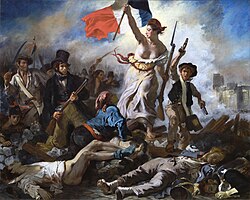
Back الثورة النيكاراغوية Arabic Сандзінісцкая рэвалюцыя Byelorussian Сандинистка революция Bulgarian Revolució Sandinista Catalan Sandinistická revoluce Czech Nicaraguanische Revolution German Nikaragva Revolucio Esperanto Revolución Sandinista Spanish Nicaragua revolutsioon Estonian Iraultza Sandinista Basque
This article has multiple issues. Please help improve it or discuss these issues on the talk page. (Learn how and when to remove these messages)
|
| Nicaraguan Revolution | |||||||
|---|---|---|---|---|---|---|---|
| Part of the Central American crisis and the Cold War | |||||||
 Clockwise from top left: FSLN guerrillas entering the city in 1979, bodies of people executed in León, a government spy captured by the FSLN, destruction of towns and villages taken by rebel forces, a bombing by the Nicaraguan National Guard, an FSLN soldier aiming an RPG-2 | |||||||
| |||||||
| Belligerents | |||||||
|
|
MAP-ML (1978–1979)
| ||||||
| Commanders and leaders | |||||||
| |||||||
| Casualties and losses | |||||||
|
1978–79: 50,000–73,000 total killed[29] 1981–89: 10,000–43,000 total killed; best estimate using most detailed battle information is 30,000 killed.[29] | |||||||
| Part of a series on |
| Political revolution |
|---|
 |
|
|
The Nicaraguan Revolution (Spanish: Revolución Nicaragüense or Revolución Popular Sandinista) began with rising opposition to the Somoza dictatorship in the 1960s and 1970s, the ouster of the dictatorship in 1978–79,[30] and fighting between the government and the Contras from 1981 to 1990. The revolution revealed the country as one of the major proxy war battlegrounds of the Cold War.
The initial overthrow of the Somoza dictatorial regime in 1978–79 cost many lives, and the Contra War of the 1980s took tens of thousands more and was the subject of fierce international debate. Because of the political turmoil, failing economy, and limited government influence, during the 1980s both the FSLN (a leftist collection of political parties) and the Contras (a rightist collection of counter-revolutionary groups) received aid from the Soviet Union and the United States, respectively.
A peace process started with the Sapoá Accords in 1988 and the Contra War ended after the signing of the Tela Accord in 1989 and the demobilization of the FSLN and Contra armies.[31] A second election in 1990 resulted in the election of a majority of anti-Sandinista parties and the FSLN lost power.
- ^ a b Research Directorate, Immigration and Refugee Board, Canada (1 May 1989). "Participation of Costa Rican government in arms smuggling, for Sandinistas in 1979 and for Contras in mid-1980's". UNHCR. Retrieved 4 December 2020.
- ^ Report of the Congressional Committees Investigating the Iran/Contra Affair, 1995. pp. 165, 271, 481.
- ^ "CIA-Contra-Crack Cocaine Controversy". Retrieved 10 April 2015.
- ^ "Reagan Says Saudi Talked of Contra Aid". tribunedigital-chicagotribune. 14 May 1987. Retrieved 10 April 2015.
- ^ a b "Saudi Arabia and the Reagan Doctrine – Middle East Research and Information Project". December 1988. Retrieved 10 April 2015.
- ^ "Understanding the Iran-Contra Affairs – the Iran-Contra Affairs".
- ^ McManus, Doyle (6 March 1987). "Private Contra Funding of $32 Million Disclosed : Leader Shows Secret Bank Data in Effort to Prove Rebels Did Not Get Money From Iran Arms Sales". Los Angeles Times. Retrieved 19 August 2019.
- ^ "The Contras, Cocaine, and Covert Operations". Retrieved 10 April 2015.
- ^ The Pinochet File: A Declassified Dossier on Atrocity and Accountability. p. 255.
- ^ "Understanding the Iran-Contra Affairs". www.brown.edu. Archived from the original on 8 June 2017. Retrieved 9 April 2017.
- ^ "Iran–Contra Hearings; Brunei Regains $10 Million". The New York Times. 22 July 1987. Retrieved 5 December 2021.
- ^ a b c "Poland and China Reportedly Sent Arms to Contras". The New York Times. 2 May 1987. Retrieved 31 March 2023.
- ^ a b c Landslide: The Unmaking of the President, 1984–1988. p. 143.
- ^ a b Brown, Jonathan C. (2022). "Omar Torrijos and the Sandinista Revolution". The Latin Americanist. 66: 25–45. doi:10.1353/tla.2022.0003. S2CID 247623108.
- ^ a b Sánchez Nateras, Gerardo (2018). "The Sandinista Revolution and the Limits of the Cold War in Latin America: The Dilemma of Nonintervention During the Nicaraguan Crisis, 1977–78" (PDF). Cold War History. 18 (2): 111–129. doi:10.1080/14682745.2017.1369046. S2CID 218576606.
- ^ Report of the Congressional Committees Investigating the Iran/Contra Affair, 1995. pp. 216, 485.
- ^ "Welcome to the Air Combat Information Group".[dead link]
- ^ "The Soviet Union and Revolutionary Warfare: Principles, Practices, and..." Retrieved 10 April 2015.
- ^ "Mexico's Support of the Sandinista Revolution". Universidad Michoacana de San Nicolás de Hidalgo.
- ^ "The Soviet Union and Revolutionary Warfare: Principles, Practices, and ..." Retrieved 10 April 2015.
- ^ a b Report of the Congressional Committees Investigating the Iran/Contra Affair, 1995. p. 27.
- ^ a b c Report of the Congressional Committees Investigating the Iran/Contra Affair, 1995. p. 485.
- ^ Dickey, Christopher (19 July 1981). "Arab States Help Nicaragua Avoid Ties to Superpowers". The Washington Post. Retrieved 2 January 2024.
- ^ Echikson, William (15 July 1982). "France Warms Up to Nicaragua – As US Fumes". The Christian Science Monitor. Retrieved 29 July 2022.
- ^ "Our work in Nicaragua". Swedish International Development Corporation Agency (www.sida.se). 2009. Archived from the original on 15 June 2013.
- ^ "Sandinistas Find Economic Ally In Socialist Sweden". philly-archives. Archived from the original on 30 December 2014. Retrieved 10 April 2015.
- ^ Bishop, Adam (2 September 2009). With Them and Against Them: Canada's Relations With Nicaragua, 1979–1990 (Master Thesis). University of Waterloo.
- ^ "Daniel Ortega", Encyclopædia Britannica (15th ed.), 1993
- ^ a b Lacina, Bethany. "The PRIO Battle Deaths Dataset, 1946–2008, Version 3.0: Documentation of Coding Decisions" (PDF). International Peace Research Institute, Oslo. Archived from the original (PDF) on 19 October 2017. Retrieved 5 August 2013.
- ^ Louis Proyect, Nicaragua, discusses, among other things, the reforms and the degree to which socialism was intended or achieved.
- ^ Uppsala Conflict Data Program Conflict Encyclopedia Nicaragua, State-based conflict, Peace efforts, https://www.ucdp.uu.se/country/93
© MMXXIII Rich X Search. We shall prevail. All rights reserved. Rich X Search